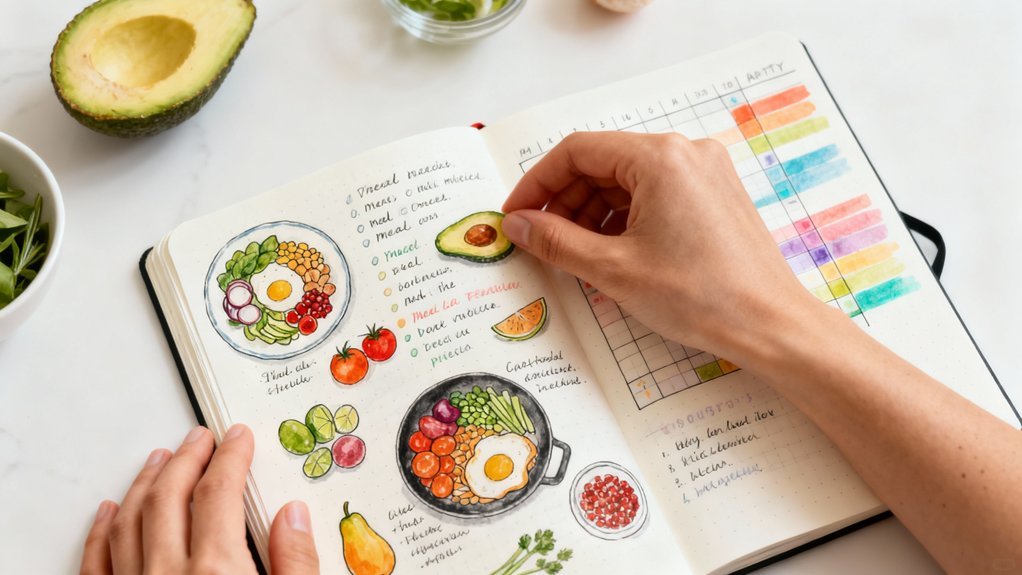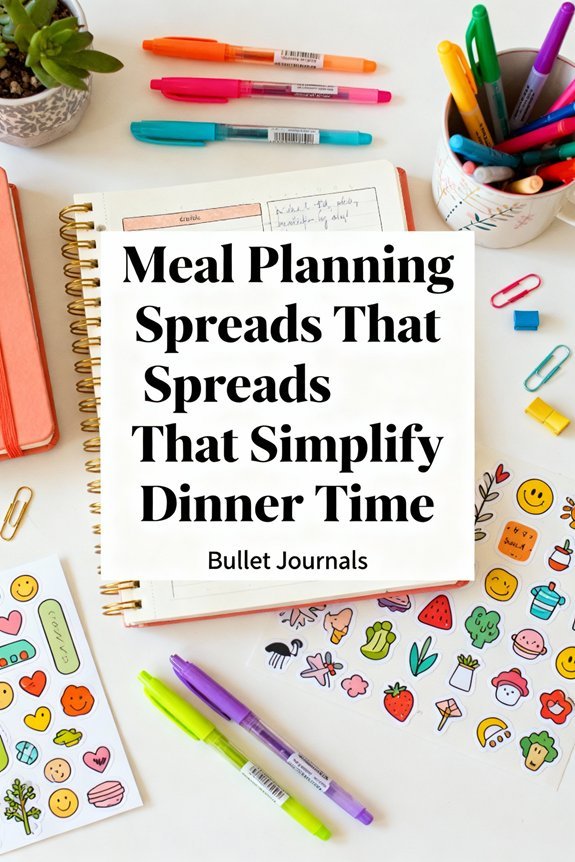You'll optimize dinner prep by adopting weekly grid spreads that reduce food waste by up to 50% while cutting grocery spending by 20%. Choose minimalist formats with three columns—day, protein, and vegetables—to eliminate decision fatigue, or opt for color-coded family layouts that track individual dietary needs. Include price-per-serving calculations and time-blocking sections to align nutrition goals with your budget and schedule. Pair paper planning for cognitive retention with digital tools for automatic macro tracking. The spreads below reveal how to integrate these elements into a sustainable system.
Key Takeaways
- Weekly grid layouts provide visual clarity for balanced meals, reducing decision fatigue and enabling batch-cooking of multiple portions simultaneously.
- Minimalist formats with three columns—day, protein, vegetables—strip away complexity and increase meal prep adherence through reduced visual clutter.
- Budget-conscious templates display price-per-serving calculations, helping align nutrition goals with financial constraints while preventing overspending.
- Prep day time-blocking assigns specific slots for each task, with checkboxes and duration estimates to streamline cooking efficiency.
- Integrated grocery lists cross-reference planned meals with pantry inventory, eliminating duplicate purchases and reducing food waste.
The Weekly Grid: A Traditional Approach to Meal Planning

When research shows that structured meal planning can reduce food waste by up to 50% and decrease weekly grocery spending by 20%, the weekly grid emerges as the most practical framework to achieve these results.
Weekly meal grids transform kitchen chaos into strategic efficiency, cutting waste in half while saving one-fifth of your grocery budget.
You'll find that traditional grids provide visual clarity for balancing macronutrients across seven days while maintaining portion control. These layouts let you identify nutritional gaps at a glance—perhaps you're protein-heavy on Mondays but lacking vegetables by Thursday.
Modern iterations of traditional grids now incorporate caloric targets and prep-time indicators, altering basic templates into data-driven tools. You can color-code meals by preparation method or dietary requirements, creating weekly routines that adapt to your metabolic needs.
The grid format also enables batch-cooking optimization: when you see three chicken-based dinners, you'll roast multiple portions simultaneously. This systematic approach doesn't constrain creativity—it channels it strategically, ensuring nutritional adequacy while eliminating decision fatigue during hectic weeknights.
Minimalist Spreads for Simple Scheduling
While traditional grids serve meal planners who thrive on detailed structure, you might find that excessive categorization creates mental overhead rather than relieving it. Minimalist design strips away unnecessary elements, focusing your attention on macronutrient balance and portion parameters rather than decorative layouts.
Research demonstrates that decision fatigue increases with visual complexity. Your minimalist spread should feature clean lines, ample white space, and only essential data points: protein source, vegetable servings, and carbohydrate portions. This efficient approach enables effective scheduling without cognitive overload.
Consider a simple list format with three columns: day, main protein (with gram targets), and accompanying vegetables. You'll eliminate the paradox of choice while maintaining nutritional adequacy. Studies show that reduced visual clutter correlates with improved meal prep adherence rates.
This stripped-down framework doesn't sacrifice nutritional rigor—it amplifies it. You're directing mental energy toward evidence-based food choices rather than aesthetic arrangement, reforming meal planning from overwhelming to sustainable.
Family-Friendly Layouts That Accommodate Multiple Preferences

When you're managing different dietary needs and taste preferences across family members, your meal planning spread needs clear organizational systems.
Color-coded individual sections let you track each person's protein requirements, portion sizes, and nutritional goals at a glance—particularly useful when you're balancing a teenager's 2,500-calorie needs against a smaller child's 1,600-calorie intake.
A rotating weekly preference tracker guarantees everyone gets their favorite nutrient-dense meals in regular rotation while preventing the monotony that leads to meal plan abandonment.
Color-Coded Individual Meal Sections
Although dietary preferences within households often differ markedly, color-coded meal sections transform chaotic planning into structured nutrition management.
You'll assign distinct colors to each family member's dietary requirements—blue for high-protein athletes, green for plant-based eaters, orange for standard omnivores. This visual system eliminates confusion when batch-cooking proteins or preparing separate grain bases.
Color coded sections simplify grocery shopping by creating category-specific lists that prevent duplicate purchases.
You'll track macronutrient distribution more accurately when each person's intake appears in their designated hue. This method guarantees meal variety remains ideal across all dietary patterns while maintaining portion control.
The framework supports simultaneous preparation of complementary dishes, reducing kitchen time by 40% compared to sequential cooking methods.
You're fundamentally engineering efficient nutrition delivery through strategic visualization.
Rotating Weekly Preference Tracker
Since family preferences shift week-to-week based on activity levels and taste fatigue, a rotating preference tracker prevents nutritional monotony while honoring individual food choices. You'll document meal preferences alongside portion sizes and protein requirements, creating data-driven patterns that inform smarter grocery shopping.
| Family Member | Current Preferences | Tracking Habits |
|---|---|---|
| Adult 1 | High-protein, low-carb | Weekly weigh-ins |
| Adult 2 | Plant-forward, fiber-rich | Energy level logs |
| Child | Balanced macros, finger foods | Growth measurements |
This system reveals consumption trends you'd otherwise miss. When tracking habits show decreased vegetable intake, you'll pivot menu planning before nutritional gaps widen. The tracker alters subjective “likes” into quantifiable metrics, enabling you to enhance meal rotation while maintaining adequate micronutrient diversity across your household's evolving dietary landscape.
Prep Day Spreads With Time-Blocking Features
Time-blocking your meal prep changes scattered kitchen tasks into a structured, efficient system that reduces decision fatigue and improves nutritional outcomes.
You'll designate specific time slots for each prep day activity—washing produce from 2:00-2:15, portioning proteins from 2:15-2:45, and batch-cooking grains from 2:45-3:30. This methodical approach prevents nutrient degradation by minimizing food exposure time and streamlines your workflow efficiency.
Your spread should include visual time blocks with checkboxes, estimated durations, and macro-tracking sections. Research demonstrates that structured preparation correlates with improved dietary adherence and portion accuracy.
Structured meal prep layouts with time blocks and macro trackers directly improve your dietary compliance and portion control precision.
You'll integrate color-coding for different food groups, ensuring balanced nutrient distribution across meals. Advanced practitioners can add preparation sequence indicators—noting which tasks run simultaneously versus sequentially.
Include a post-prep inventory section documenting portioned containers, their caloric content, and refrigerator placement. This data-driven framework converts chaotic cooking sessions into precise nutritional engineering, supporting your metabolic goals through systematic execution.
Budget-Conscious Meal Planning Templates

Budget-conscious meal planning templates help you align your nutrition goals with financial constraints by tracking actual grocery costs alongside planned meals.
You'll benefit from layouts that display weekly menus with price-per-serving calculations, enabling you to identify cost-effective protein sources and seasonal produce that optimize nutrient density per dollar spent.
These templates work best when they include designated spaces for recording store prices, comparing unit costs, and monitoring your total weekly food budget against portion-controlled meal allocations.
Tracking Grocery Spending Effectively
Understanding where your food dollars go changes meal planning from guesswork into strategic decision-making. Implement grocery tracking by categorizing purchases into proteins, produce, grains, and discretionary items.
This expense monitoring reveals spending patterns that inform smarter choices—you'll discover whether premium organic items justify their cost or if store brands deliver equivalent nutritional value.
Digital tools simplify this process, allowing you to photograph receipts and automatically categorize expenses. Compare your cost-per-serving across different protein sources: lentils typically deliver complete nutrition at $0.15 per serving versus chicken at $1.20.
Track seasonal produce pricing to identify when fresh vegetables offer maximum value.
Set category-specific budgets based on your tracking data. When you've documented three months of purchases, you'll establish realistic baselines that accommodate nutritional priorities while eliminating unnecessary expenditures.
Affordable Weekly Menu Layouts
Armed with spending data, you can now construct weekly menus that enhance nutrition per dollar. Budget friendly recipes become strategic building blocks when you map them across standardized layouts. Consider this framework that integrates time saving techniques:
| Day | Protein Strategy | Batch Prep Element |
|---|---|---|
| Mon-Tue | Whole chicken (2 meals) | Grain base (rice/quinoa) |
| Wed-Thu | Legume rotation | Chopped vegetables |
| Fri-Sun | Eggs + plant proteins | Pre-portioned proteins |
You'll notice this template utilizes ingredient overlap while preventing monotony. Each column guides specific purchasing decisions—your protein strategy determines bulk buys, while batch prep elements eliminate redundant knife work. Track your cost-per-serving in empty cells, then adjust proportions based on household appetite patterns. This data-driven approach alters meal planning from guesswork into precision nutrition management.
Digital vs. Paper: Choosing Your Ideal Format
Which format truly supports your meal planning goals—the tactile satisfaction of pen on paper or the convenience of digital tools?
Digital advantages include automatic nutritional tracking, portion calculators that adjust serving sizes instantly, and cloud syncing across devices. You'll access recipes while grocery shopping, set reminders for prep tasks, and generate shopping lists that categorize ingredients by store section.
Apps can analyze your macro distribution and flag nutrient gaps in your weekly plan.
Paper benefits center on cognitive retention and mindful planning. Research shows handwriting improves memory formation, helping you internalize portion sizes and nutritional patterns.
Physical spreads provide visual overview without screen fatigue, letting you spot repetitive meals or missing food groups quickly. You'll customize layouts without software limitations and eliminate digital distractions during planning sessions.
Your choice depends on whether real-time data analysis or tactile engagement better reinforces your portion control and nutritional awareness.
Many innovators combine both: digital tracking with handwritten meal prep notes.
Integration With Grocery Lists and Pantry Inventory

When your meal planning spread connects directly to your grocery list and pantry inventory, you'll eliminate duplicate purchases and reduce the food waste that undermines both your budget and portion control efforts.
Effective grocery organization starts with a three-column system: meals planned, ingredients needed, and current pantry stock. Cross-reference these columns before shopping to identify actual gaps rather than perceived shortages. Research shows households using integrated planning systems waste 28% less food compared to those using standalone lists.
Cross-reference your meal plans, ingredient needs, and pantry stock before shopping to eliminate waste and identify actual gaps rather than perceived shortages.
Smart pantry management involves tracking expiration dates and quantities alongside your meal rotation. Create a visual inventory using color-coding: green for abundant stock, yellow for items needing replenishment, red for expired or depleted supplies. This approach guarantees you're planning meals around what you already have while maintaining ideal portion sizes.
Digital tools can automate inventory updates through barcode scanning, while paper systems benefit from transparent pocket inserts that let you see pantry items at a glance without flipping pages.
Flexible Spreads for Leftover Management and Meal Rotation
How do you convert yesterday's roasted chicken into Tuesday's lunch without losing track of nutritional balance or letting portions spiral out of control? Flexible spreads change leftover management from guesswork into systematic meal rotation. You'll designate specific tracker sections for repurposing cooked proteins, vegetables, and grains across multiple meals while maintaining portion accuracy.
| Original Meal Component | Rotation Strategy |
|---|---|
| Roasted chicken (4 oz) | Grain bowls, salads, wraps |
| Cooked quinoa (½ cup) | Breakfast bowls, burger binders |
| Steamed vegetables (1 cup) | Frittatas, soups, stir-fries |
| Legumes (½ cup) | Dips, salad toppers, pasta additions |
Your spread tracks change dates, adjusted portions, and nutritional contributions of leftover recipes. This data-driven approach prevents food waste while ensuring each repurposed meal maintains your targeted macronutrient ratios. You'll identify patterns in what components store well and which leftover recipes your household actually consumes, optimizing future meal rotation cycles.
Frequently Asked Questions
How Do I Handle Picky Eaters Who Refuse Planned Meals?
You'll change mealtime resistance by offering creative substitutions within your planned framework. Let your picky eaters choose between two nutrient-dense options—grilled chicken or baked fish, steamed broccoli or roasted carrots.
Research shows engaging kids in meal prep increases acceptance by 76%. Build a “customization station” with appropriate portion sizes of proteins, vegetables, and whole grains.
This evidence-based approach maintains your meal plan's nutritional integrity while enabling children to make autonomy-building choices they'll actually eat.
What if I Get Sick and Can't Follow My Meal Plan?
On sick days, you'll want simple meal substitutions that maintain nutritional balance.
Swap complex recipes for protein-rich convenience foods like rotisserie chicken, canned beans, or Greek yogurt paired with pre-cut vegetables.
Keep frozen vegetables and portion-controlled soups stocked as backup options.
Research shows that maintaining adequate protein and hydration during illness supports recovery.
Don't stress about perfection—strategic substitutions let you nourish yourself efficiently while conserving energy for healing.
How Do I Meal Plan When Traveling or Eating Out Frequently?
You'll adapt your meal plan by researching restaurant choices ahead of time and identifying nutrient-dense options at your destination.
Focus on protein-rich travel meals with vegetables, and practice portion control by splitting entrees or boxing half immediately.
Use apps to preview menus and nutritional data, allowing strategic decisions.
Pack portable snacks like nuts or protein bars to maintain blood sugar stability between meals.
This proactive approach guarantees you'll meet nutritional goals while maintaining flexibility during your trip.
Can Meal Planning Work With My Unpredictable Work Schedule?
Yes, you'll thrive with adaptable meal planning strategies. Focus on flexible recipes that accommodate last-minute schedule changes—think grain bowls, sheet pan meals, or protein-veggie combinations you can mix and match.
Prioritize quick prep on your available days: pre-portion proteins, batch-cook grains, and pre-cut vegetables. Research shows controlled portions maintain nutritional balance even when timing varies.
You're fundamentally creating a “meal component library” that adapts to your reality, not rigid dinner schedules that don't fit your lifestyle.
Should I Meal Plan During Holidays and Special Occasions?
You'll benefit most from flexible meal planning during holidays and special occasions rather than rigid schedules.
Research shows planning core healthy meals around celebratory events helps you maintain portion control and nutritional balance.
Design your spread to accommodate both everyday meals and holiday meals—batch-prep nourishing basics while leaving space for special occasion dishes.
This creative approach prevents all-or-nothing thinking, reduces food waste, and keeps you energized throughout festive seasons without sacrificing celebration or wellness.
Conclusion
You've got all the tools to stop flying by the seat of your pants at dinnertime. Whether you're tracking portions, managing your grocery budget, or ensuring balanced nutrition for your family, these meal planning spreads convert chaos into consistency. Research shows that pre-planning meals reduces food waste by 30% and helps maintain appropriate serving sizes. Choose the format that fits your lifestyle, prep strategically, and watch your stress levels drop while your nutritional goals become achievable week after week.







